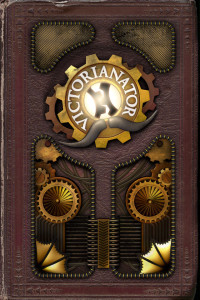
In 2011, the Ludic Voice Team, headed by Jason Camlot, created a game with the goal of exploring gesture and Victorian elocution practices. Articles in Wired and the Globe and Mail couldn’t quite agree on what the app made players sound like, but it was somewhere between actually Victorian, Steampunk and Ian McKellen.
Maybe I don’t have a voice that lends itself well to being Ian McKellen, but my experience was fairly different from any of these. My favourite description is from the New Yorker, which calls the game “a cross between a poetry reading and Wii Sports.”
In my experience, all of my original recordings, in monotone, make me sound dead (tired), and the more I gesticulated with my iPhone, the more digitized I sounded. This is something that Jason Camlot addresses in his article for the Victorian Poetry Network:
“None of the synthetic effects that are triggered by gesture to ‘Victorianate’ the players voice are very Victorian in quality. For example, we were aiming for a Tremor akin to that of Victorian actor Lewis Waller reciting Tennyson’s ‘Charge of the Light Brigade’. But what we ended up with is something closer to Peter Frampton’s talkbox guitar solo in ‘Do You Feel Like We Do’.”
Actually, I was reminded of Neil Young’s ‘Transformer Man.’ But clearly this is something of which Camlot and presumably the Ludic Voice team are aware.
Since Jason Camlot’s article already contains a sophisticated exploration of the process behind the creation of the Victorianator, and the historiographical implications of its steampunk aesthetic and the fact that it is a game one plays on that symbol of modern innovation and decadence (I kid), the iPhone, I will try to limit myself to a player’s perspective. Rather than discussing the concepts behind the game design choices, I think it is valuable to examine the game in terms of what is visible to the player.
Depending on one’s perspective, access to the story tied into The Victorianator comes with different implications. Are we “unlocking” the story of Silas, or are “progressing” his story? The rhetoric matters because it changes the way that we think of the player’s agency and the gameplay as a whole. If we are only unlocking Silas’ story, then the story is a reward that is given for good performance. If we are responsible for the progression of Silas’ story and responsible for his fate, we have a direct impact on his rise or fall in Victorian society based on how good we are at one: reading in monotone and two: correctly modulating that monotone according to a set of predetermined rules. The problem then, is that the expectations of the game are not entirely made clear. I feel bad for Silas if truly he is relying on my performance to help him through Victorian society.
I had hoped for a little more unity in terms of the rationalization for the combination of different game aspects. Not knowing where to situate Silas’ diary (as a reward or as something that I can impact), I don’t really have clear knowledge about what my motivation, as a Victorian poetry reader, is. The name of the game implies that this is just a matter of transformation, or that the only motivation that one needs to play a game called The Victorianator is because one can be Victorianated, which is cool. Similarly, who is the helpful tutorial robot, and is he a stand-in in other ways for the player? That would be interesting, since the result sounds so mechanized. Here’s a thought: what if The Victorianator’s reality is one in which robots were trying to figure out Victorian poetry and elocution in some distant future where humans no longer exist?
Camlot suggests that The Victorianator shares some similarities with and draws inspiration from games like Guitar Hero or Rock Band. This is problematic in The Victorianator. The signposts of success in these other games are clear: if you are playing well, your guitar doesn’t make unpleasant noises that signal false notes, your score increases, and the song that you are playing sounds like other versions of that song with which one can compare them. In The Victorianator, I don’t know what a good performance sounds like, and even if I am performing well, I don’t sound Victorian and I don’t even necessarily sound particularly pleasant to listen to. I guess what the game lacks is some kind of signpost like a points system, since there are no master recordings that are accessible as self-checks while one is playing. The meter on the screen is small, and unfortunately difficult to look at during the recording process (if I got distracted, I had trouble continuing to read through the poem) and nearly impossible to look at while one gesticulates wildly with one’s phone.
I guess the fact that most people don’t like to listen to themselves on a recording might have something to do with my lack of enjoyment of the gameplay, since I have to both record myself and then perform gestures while listening to myself. Does anyone remember that “speech jamming gun” that plays back your own words to you?
I realize that for a game like The Victorianator, the conceptualization and the process is, in many ways, more important than the end result. The challenges that the team set up for itself are impressive, and on most counts they have achieved wonderful results. The art design of the game is lovely and charming. The writing is excellent – Silas’ diary, especially where it digresses into discussions of mustache styles, is entertaining, and often touching. I enjoyed the interface and the use of motion is innovative and well-designed, especially for an iPhone game. I like the project, and despite the criticisms that I’ve pointed out above, genuinely enjoyed playing it. Also, if anyone ever makes a similar game with the reading of Middle English texts, I will playtest it for free and be your best friend.
In case you missed the links further up, you can read articles about The Victorianator on the Wired.Com, New Yorker, Globe and Mail and Victorian Poetry Network websites. The Victorianator is available for free on iTunes.
